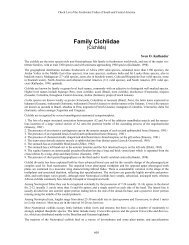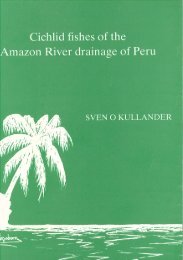Open Access PDF - Sven Kullander
Open Access PDF - Sven Kullander
Open Access PDF - Sven Kullander
You also want an ePaper? Increase the reach of your titles
YUMPU automatically turns print PDFs into web optimized ePapers that Google loves.
Fig. 73. Cichla pinima, fresh caught adult specimen, not preserved. Brazil: Para: Rio Guamá, downstream of Ourém.<br />
Photograph by F. Warzel.<br />
Fig. 74. Cichla cf. pinima, MZUSP 22094, 161 mm SL; Brazil: Amapá: Cachoeira Grande.<br />
lated with narrow white ring appear in three<br />
positions, one on postorbital portion of cheek,<br />
one dorsally on opercle, and one on posterodorsal<br />
tip of subopercle; occasionally one marking<br />
in each position, but normally several small spots<br />
in each position. In holotype an ocellated blotch<br />
present at ventral tip of opercle, but no dark blotch<br />
observed at anterodorsal process of preopercle.<br />
Dorsal and caudal fins nearly uniformly dark,<br />
immaculate or with light spots similar to nonbreeding<br />
specimens. Caudal ocellus black with<br />
complete white ring; size same as eye. Anal fin<br />
whitish basally, turning greyish distally. Pelvic<br />
fin all white or grey on lateral face.<br />
Specimens 111-135 mm SL from the blackwa-<br />
Ichthyol. Explor. Freshwaters, Vol. 17, No. 4<br />
365<br />
ter Rio Arapiuns (Fig. 73) much darker than all<br />
Tapajós specimens, featuring contrasting yellowish<br />
white spots on body similar to much larger<br />
specimens (non breeding adults, see above), including<br />
rows accompanying lateral band, two or<br />
three rows on dorsum, and one row of a few spots<br />
only on abdominal side. In similar sized Tapajós<br />
and Xingu specimens yellow spots found only<br />
along lateral band and commonly only along<br />
dorsal border of band. Specimens 66-134 mm SL<br />
from the Rio Paraguaçu similar to Arapiuns<br />
specimens in colour pattern.<br />
Live colouration. Live or freshly killed specimens<br />
in breeding pattern (Fig. 74) yellow, especially




